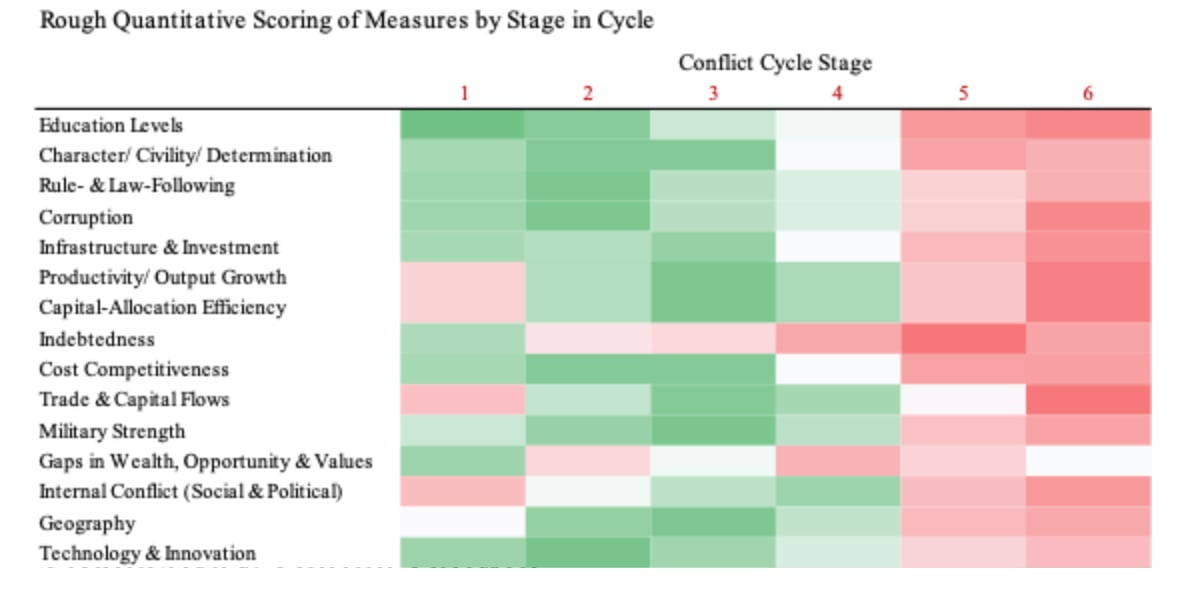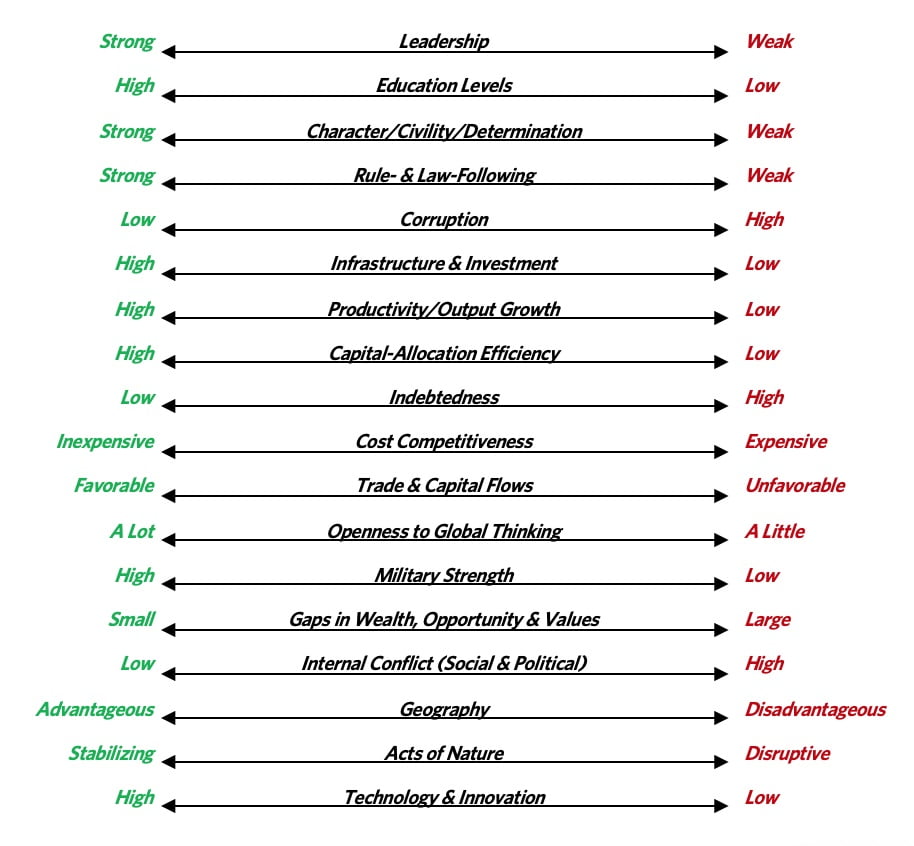Ray Dalio has published the latest installments Chapter 8 and Chapter 9 of his “Changing World Order” study, which focuses on the cycles of internal order and disorder. Ray Dalio explores the timeless and universal cause/effect relationships that shape internal orders and behaviors that ultimately drive the shifts between periods of order and disorder.
Q3 2020 hedge fund letters, conferences and more
With a specific focus on the US, Ray explains how the US is at a tipping point in which it could go from manageable internal tension to revolution and/or civil war. However, he emphasizes that the best internal systems/orders depend on the circumstances at the time, and outlines why now is an important time to know and watch these markers to understand the full range of possibilities for our future.
The new installments dive into the following:
- The four timeless and universal dynamic forces Ray believes are most important in driving changes:
- The wealth and power class struggle dynamic
- The balance of power dynamic
- The dynamic of favoring short-term enjoyment over long-term health
- The failure to learn from history
- The six stages of the internal cycle, which Ray reviews with a focus on the US:
- The new order begins and the new leadership consolidates power
- The resource-allocation systems and government bureaucracies are built and refined
- There is peace and prosperity
- Peace and prosperity contributes to great excesses in spending and debt and the widening of wealth and political gaps
- There are very bad financial conditions and intense conflict stemming from the wealth and political gaps
- Civil wars/revolutions if problems are not properly addressed
Chatper 8: The Archetypical Cycle Of Internal Order And Disorder
Executive Summary
How people are with each other is the primary driver of the outcomes they get. Within countries there are systems or “orders” for governing how people are supposed to behave with each other. These systems and the actual behaviors of people operating within them produce their consequences. In the next two chapters we will explore the timeless and universal cause/effect relationships that shape the internal orders that people have and the behaviors that drive the shifts between periods of order and periods of disorder.
We are now seeing growing disorder in a number of leading countries around the world, most importantly in the United States. I wanted to put that disorder into context so I did the research I am sharing in these chapters. Because how the US handles its disorder will have profound implications for Americans, others around the world, and most economies and markets, in these two chapters I am focusing more on the US than on other countries, though I will follow these chapters with examinations of other leading countries.
The following chart shows in a simplified way where the US is within the archetypical Big Cycle as determined by the previously described measures that drive the rise and decline of empires. It is in this stage when there are bad financial conditions and intensifying conflict. Classically this stage comes after periods of great excesses in spending and debt and the widening of wealth and political gaps and before there are revolutions and civil wars. The United States is at a tipping point in which it could go from manageable internal tension to revolution and/or civil war. To be clear, I am not saying that the United States or other countries are inevitably headed that way; however, I am saying that now is an especially important time to know and watch the markers in order to understand the full range of possibilities for the period ahead. In this chapter, I explore those markers by drawing on the lessons from analogous historical cases.
Because the subject is so important I want it to be complete, which has made it more than 40 pages long, so I put it in two chapters: Chapter 8 is “The Archetypical Cycle of Internal Order and Disorder” and Chapter 9 is “Delving into the Six Stages of the Internal Cycle with a Particular Focus on the US Now” (see Chapter 9 here: https://www.linkedin.com/pulse/delving-six-stages-internal-cycle-particular-focus-us-ray-dalio).
Remember: if you want to get through this quickly you can just read the highlights, which are in bold. Principles are in bold and italics.
Read the full article here.
Chapter 9: Delving Into The Six Stages Of The Internal Cycle With A Particular Focus On The US Now
Internal orders typically (though not always) change through a relatively standard sequence of stages, like how a disease progresses. By looking at their symptoms we can tell what stages they are in. For example, just as Stage 3 cancer is different from Stage 4 cancer in ways defined by different conditions that exist and have come about as a result of things that happened in prior stages, the same is true for the different stages of the big internal order/disorder cycle. Like diseases, different conditions warrant different actions to address them and they produce a different range of probabilities that those actions will produce. For example, an old, unhealthy set of circumstances produces a range of possibilities and warrants different actions than a young, healthy set. As with cancer, it is best to stop the progress before getting into the later stages.
Below is the list of measures of health that I first passed along to you in Chapter 1. Most of these measures of health can be quantitatively measured to create a country’s health index. When the ratings of each of these items are strong/good (i.e., on the left side of the continuum) the health is strong/good and the period ahead is much more likely to be strong/good; when the ratings of these items are weak/bad, the condition of the country is weak and the period ahead is more likely weak/bad. The dimensions that we are measuring the strengths of are the most important determinants of total strength. In this chapter we will examine how these conditions together define a stage, so one will be able to look at the conditions that exist to tell what stage a country is in and then come up with a prognosis. In the concluding chapter of this book, which is on the future, I will show each country’s ratings for each of these measures, as well as use them in my attempt to explore what might be ahead. For now I just want to convey the concepts.
These strengths evolve together in archetypical ways to create the stages of the archetypical cycle. By using markers of them, we can identify where in the cycle each country, state, and city is and form our expectations of what the probabilities of different next developments will be based on the conditions at hand. In the following table, to help convey the picture, I converted most of our measures into colors with bright green being a very favorable reading and bright red being a very unfavorable reading. It is the average of these readings that defines at what stage the cycle is in, in much the same way as it was the average of the eight readings of power that I used as my measure of total power. Like those power readings, while one could reconfigure them to produce marginally different readings, they are broadly indicative in a by-and-large way. I am showing this to exemplify the typical process, not to look at any specific cases. I will look at the specific cases and their readings in the conclusion of this study.
Read the full article here.








